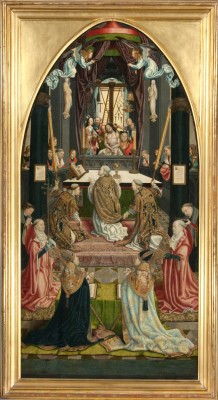A sumptuous exhibition of medieval embroidered art made of gold and silk in the Museum Catharijneconvent shows some of the best preserved medieval liturgical garments preserved in Europe.

Museum Catharijneconvent has one of the finest collections of late medieval Netherlandish vestments in the world. It may sound paradoxical, but it was actually thanks to the mobs of the sixteenth-century iconoclasts that these ecclesiastical garments became relatively well preserved. Unlike the statues in a church they were easy to spirit away and store in Catholic homes. Here they were kept and venerated for centuries without being subjected to the wear and tear, which was characteristic for similar vestments which were in constant use in the part of Europe, which Catholic.
Like the church itself and all its furnishings, the vestments worn at Mass were considered a tribute to God. Hence the fabrics were very costly and the embroidery of the highest artistic quality. Made of gold thread and silk, they were among the most precious possessions of a church or religious house.
Some of the pieces were made by named artists and may be said to be on par with some of the more famous late medieval art from Flanders.
One of the highlights of the exhibition is the four golden garments, which used to belong to David of Burgundy, who was bishop of Utrecht from 1456 to 1496. The set consists of a cope, a chasuble and two dalmatics. For the first time since 1987 it is possible to see these garments together as the chasuble from St. Paul’s Cathedral in Liege has been reunited with the cope and dalmatics of the Catharijneconvent.
The exhibition also showcases works that have served as models for the embroidery on the garments. Relatively unknown is that acclaimed painters as the Master of Alkmaar (active ca. 1490-1510) and Jacob Cornelisz van Oostsanen (ca. 1475-1533) also designed embroidery. These artists were very popular and worked for wealthy churches and monasteries as well as for rich merchants.
Museum Catharijnenconvent
 The Museum Catharijnenconvent – St. Catherine’s Convent Museum – is located in the former convent of St. Catherine. Its collections include a wide variety of religious art –historical objects from the Middle Ages and up until our time. The collection includes richly illustrated manuscripts, book-bindings decorated with precious stones, richly-worked images, paintings, altarpieces, pieces of clothing and ecclesiastical objects in gold and silver. One of the highlights of the collection is ivory objects from the early medieval Church of St. Lebuinus
The Museum Catharijnenconvent – St. Catherine’s Convent Museum – is located in the former convent of St. Catherine. Its collections include a wide variety of religious art –historical objects from the Middle Ages and up until our time. The collection includes richly illustrated manuscripts, book-bindings decorated with precious stones, richly-worked images, paintings, altarpieces, pieces of clothing and ecclesiastical objects in gold and silver. One of the highlights of the collection is ivory objects from the early medieval Church of St. Lebuinus
Museum Catharijneconven
Utrecht, Netherlands
10.04.2015 – 16.08.2015
Het geheim van de Middeleeuwen from Museum Catharijneconvent on Vimeo.
Een bijzonder transport from Museum Catharijneconvent on Vimeo.
The making of Het geheim van de Middeleeuwen in Museum Catharijneconvent from Museum Catharijneconvent on Vimeo.
Een kijkje achter de schermen: het geheim van de Middeleeuwen from Museum Catharijneconvent on Vimeo.
